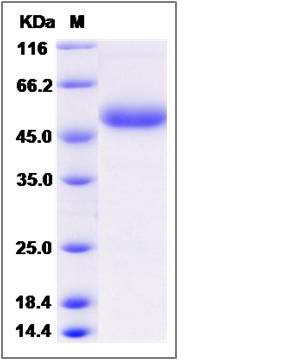Cynomolgus / Rhesus CTLA4 / CD152 Protein (Fc Tag)
CTLA4
- 100ug (NPP1214) Please inquiry
| Catalog Number | P90213-C02H |
|---|---|
| Organism Species | Cynomolgus |
| Host | Human Cells |
| Synonyms | CTLA4 |
| Molecular Weight | The recombinant cynomolgus/rhesus CTLA4 is a disulfide-linked homodimer. The reduced monomer comprises 366 amino acids and has a calculated molecular mass of 40.4 KDa.The apparent molecular mass of the protein is approximately 52 KDa respectively in SDS-PAGE. |
| predicted N | Ala 37 |
| SDS-PAGE |  |
| Purity | > 95 % as determined by SDS-PAGE |
| Protein Construction | A DNA sequence encoding the cynomolgus/rhesus CTLA4 (Q9BDC4) (Met1-Asp161) was expressed with the Fc region of human IgG1 at the C-terminus. Cynomolgus and Rhesus CTLA4 sequences are identical. |
| Bio-activity | Measured by its binding ability in a functional ELISA. Immobilized human B7-1-His (P10698-H08H) at 10 μg/ml (100 μl/well) can bind Cynomolgus CTLA4-Fc (P90213-C02H), The EC50 of Cynomolgus CTLA4-Fc is 6.0-14.5 ng/ml. |
| Research Area | Immunology |Adaptive Immunity |Costimulation & Costimulatory Molecule |B7/CD28 Family |
| Formulation | Lyophilized from sterile PBS, pH 7.4 1. Normally 5 % - 8 % trehalose, mannitol and 0.01% Tween80 are added as protectants before lyophilization. Specific concentrations are included in the hardcopy of COA. |
| Background | Cytotoxic T-lymphocyte protein 4, also known as CTLA4 and CD152, is a single-pass type I membrane protein and a member of the immunoglobulin superfamily. It is the second member of the CD28 receptor family. The ligands or counterreceptors for these two proteins are the B7 family members, CD80 (B7-1) and CD86 (B7-2). CTLA4 transmits an inhibitory signal to T cells, whereas CD28 transmits a stimulatory signal. Intracellular CTLA4 is also found in regulatory T cells and may play an important role in their functions. CD152 or cytotoxic T lymphocyte antigen-4 (CTLA-4) is an essential receptor involved in the negative regulation of T cell activation. Because of its profound inhibitory role, CD152 has been considered a sound susceptible candidate in autoimmunity and a persuasive target for cancer immunotherapy. In particular, recent evidence suggests that CD152 is also important in the homeostasis and function of a population of suppressive cells, termed regulatory T cells (Treg). |
| Reference |
